Accounting for Intangible Assets: Human Capital Recognition
VerifiedAdded on 2019/12/04
|10
|3022
|148
Report
AI Summary
This report delves into the contemporary debate surrounding the accounting treatment of human capital, specifically addressing whether it should be recognized as an intangible asset on the balance sheet. It begins by defining intangible assets and outlining relevant IAS regulations, emphasizin...
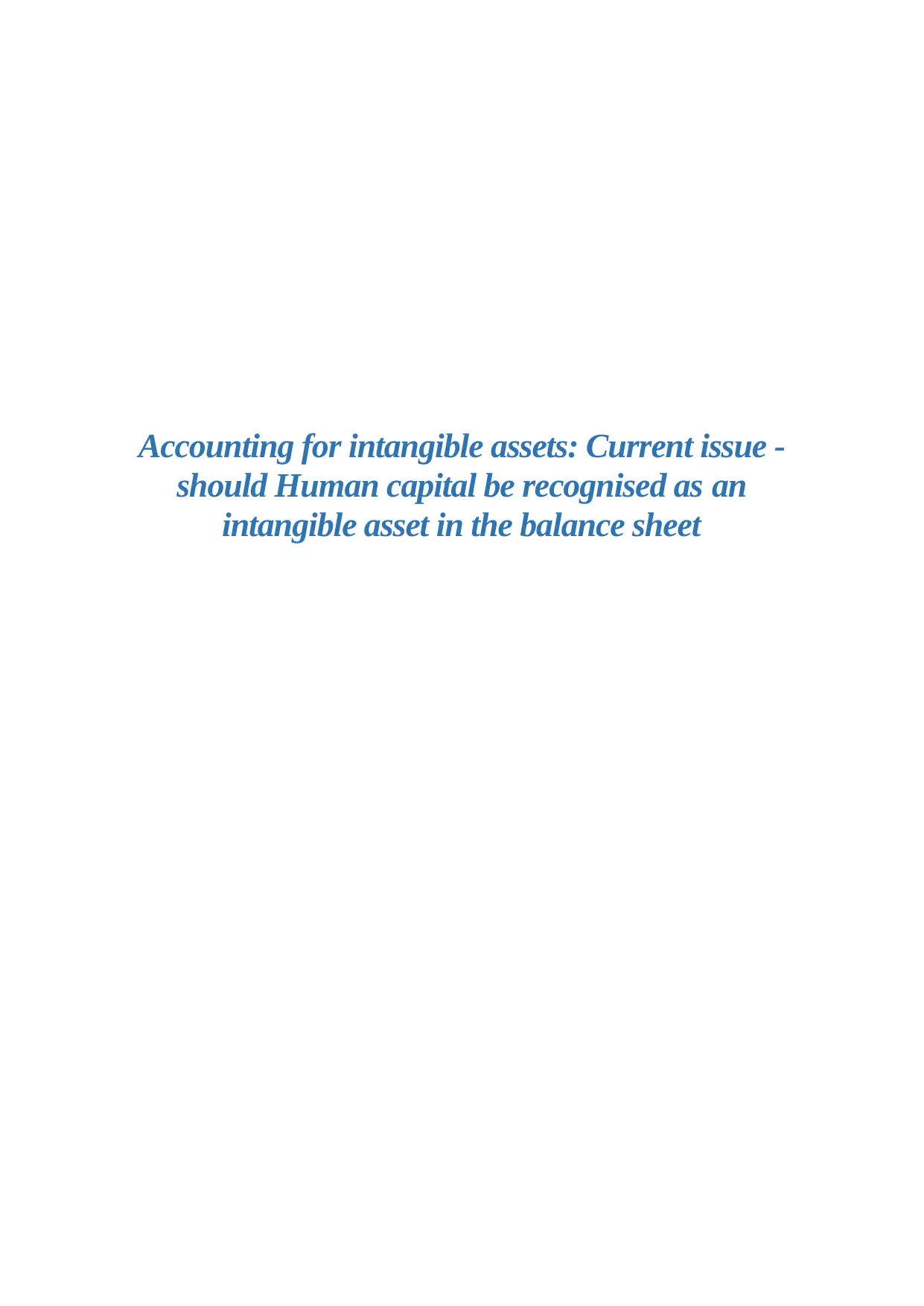
Accounting for intangible assets: Current issue -
should Human capital be recognised as an
intangible asset in the balance sheet
should Human capital be recognised as an
intangible asset in the balance sheet
Paraphrase This Document
Need a fresh take? Get an instant paraphrase of this document with our AI Paraphraser
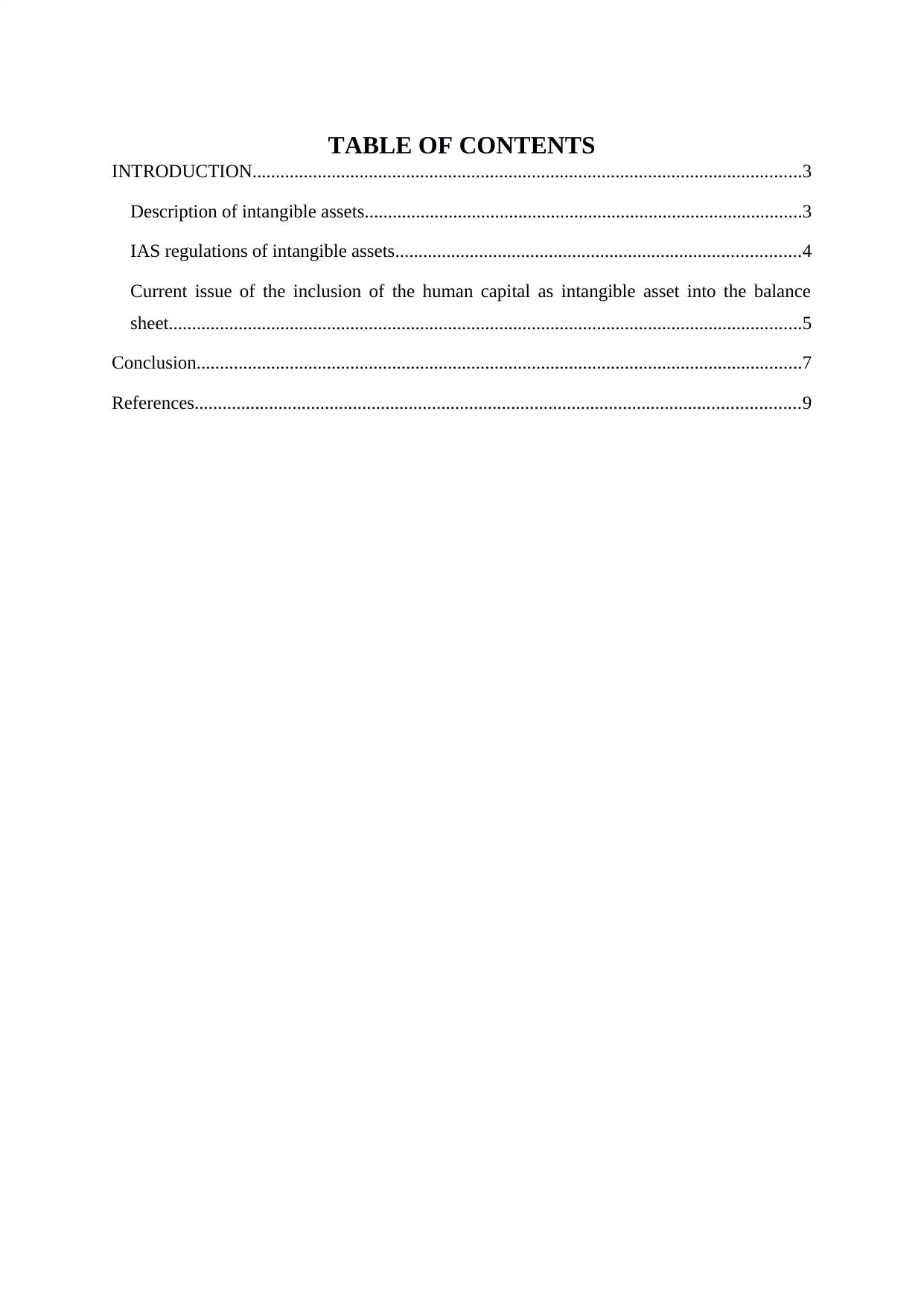
TABLE OF CONTENTS
INTRODUCTION......................................................................................................................3
Description of intangible assets..............................................................................................3
IAS regulations of intangible assets.......................................................................................4
Current issue of the inclusion of the human capital as intangible asset into the balance
sheet........................................................................................................................................5
Conclusion..................................................................................................................................7
References..................................................................................................................................9
INTRODUCTION......................................................................................................................3
Description of intangible assets..............................................................................................3
IAS regulations of intangible assets.......................................................................................4
Current issue of the inclusion of the human capital as intangible asset into the balance
sheet........................................................................................................................................5
Conclusion..................................................................................................................................7
References..................................................................................................................................9
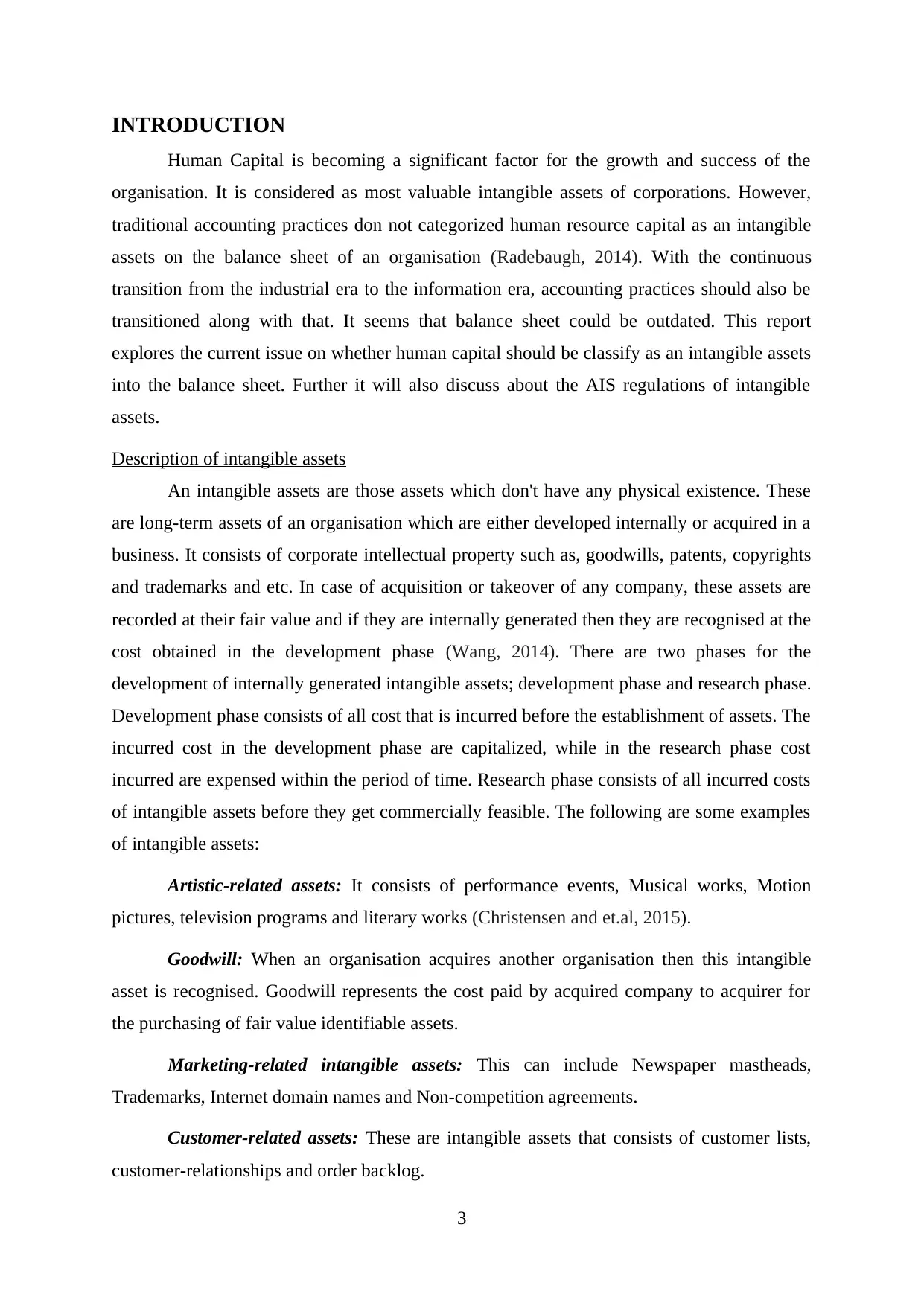
INTRODUCTION
Human Capital is becoming a significant factor for the growth and success of the
organisation. It is considered as most valuable intangible assets of corporations. However,
traditional accounting practices don not categorized human resource capital as an intangible
assets on the balance sheet of an organisation (Radebaugh, 2014). With the continuous
transition from the industrial era to the information era, accounting practices should also be
transitioned along with that. It seems that balance sheet could be outdated. This report
explores the current issue on whether human capital should be classify as an intangible assets
into the balance sheet. Further it will also discuss about the AIS regulations of intangible
assets.
Description of intangible assets
An intangible assets are those assets which don't have any physical existence. These
are long-term assets of an organisation which are either developed internally or acquired in a
business. It consists of corporate intellectual property such as, goodwills, patents, copyrights
and trademarks and etc. In case of acquisition or takeover of any company, these assets are
recorded at their fair value and if they are internally generated then they are recognised at the
cost obtained in the development phase (Wang, 2014). There are two phases for the
development of internally generated intangible assets; development phase and research phase.
Development phase consists of all cost that is incurred before the establishment of assets. The
incurred cost in the development phase are capitalized, while in the research phase cost
incurred are expensed within the period of time. Research phase consists of all incurred costs
of intangible assets before they get commercially feasible. The following are some examples
of intangible assets:
Artistic-related assets: It consists of performance events, Musical works, Motion
pictures, television programs and literary works (Christensen and et.al, 2015).
Goodwill: When an organisation acquires another organisation then this intangible
asset is recognised. Goodwill represents the cost paid by acquired company to acquirer for
the purchasing of fair value identifiable assets.
Marketing-related intangible assets: This can include Newspaper mastheads,
Trademarks, Internet domain names and Non-competition agreements.
Customer-related assets: These are intangible assets that consists of customer lists,
customer-relationships and order backlog.
3
Human Capital is becoming a significant factor for the growth and success of the
organisation. It is considered as most valuable intangible assets of corporations. However,
traditional accounting practices don not categorized human resource capital as an intangible
assets on the balance sheet of an organisation (Radebaugh, 2014). With the continuous
transition from the industrial era to the information era, accounting practices should also be
transitioned along with that. It seems that balance sheet could be outdated. This report
explores the current issue on whether human capital should be classify as an intangible assets
into the balance sheet. Further it will also discuss about the AIS regulations of intangible
assets.
Description of intangible assets
An intangible assets are those assets which don't have any physical existence. These
are long-term assets of an organisation which are either developed internally or acquired in a
business. It consists of corporate intellectual property such as, goodwills, patents, copyrights
and trademarks and etc. In case of acquisition or takeover of any company, these assets are
recorded at their fair value and if they are internally generated then they are recognised at the
cost obtained in the development phase (Wang, 2014). There are two phases for the
development of internally generated intangible assets; development phase and research phase.
Development phase consists of all cost that is incurred before the establishment of assets. The
incurred cost in the development phase are capitalized, while in the research phase cost
incurred are expensed within the period of time. Research phase consists of all incurred costs
of intangible assets before they get commercially feasible. The following are some examples
of intangible assets:
Artistic-related assets: It consists of performance events, Musical works, Motion
pictures, television programs and literary works (Christensen and et.al, 2015).
Goodwill: When an organisation acquires another organisation then this intangible
asset is recognised. Goodwill represents the cost paid by acquired company to acquirer for
the purchasing of fair value identifiable assets.
Marketing-related intangible assets: This can include Newspaper mastheads,
Trademarks, Internet domain names and Non-competition agreements.
Customer-related assets: These are intangible assets that consists of customer lists,
customer-relationships and order backlog.
3
⊘ This is a preview!⊘
Do you want full access?
Subscribe today to unlock all pages.

Trusted by 1+ million students worldwide
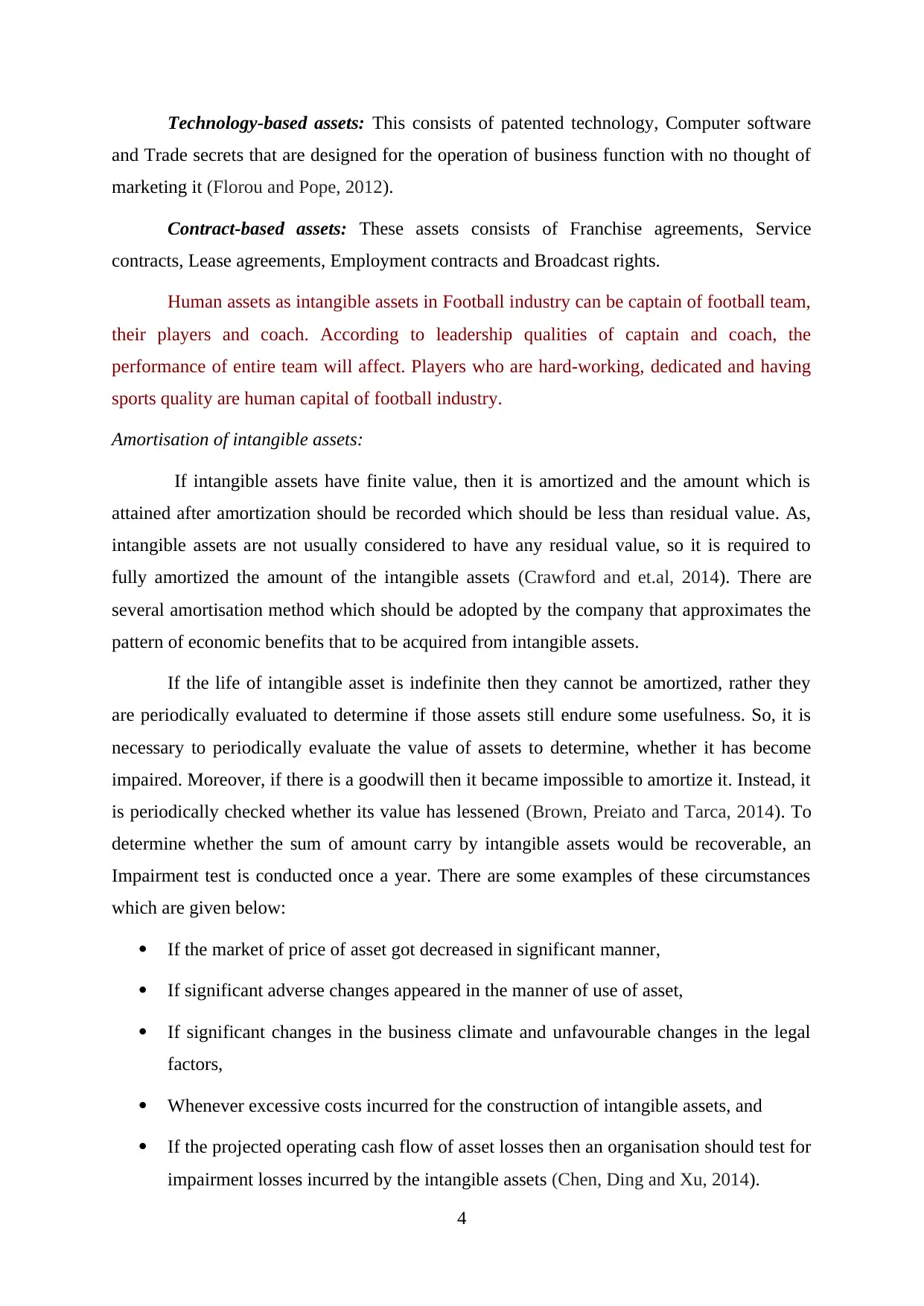
Technology-based assets: This consists of patented technology, Computer software
and Trade secrets that are designed for the operation of business function with no thought of
marketing it (Florou and Pope, 2012).
Contract-based assets: These assets consists of Franchise agreements, Service
contracts, Lease agreements, Employment contracts and Broadcast rights.
Human assets as intangible assets in Football industry can be captain of football team,
their players and coach. According to leadership qualities of captain and coach, the
performance of entire team will affect. Players who are hard-working, dedicated and having
sports quality are human capital of football industry.
Amortisation of intangible assets:
If intangible assets have finite value, then it is amortized and the amount which is
attained after amortization should be recorded which should be less than residual value. As,
intangible assets are not usually considered to have any residual value, so it is required to
fully amortized the amount of the intangible assets (Crawford and et.al, 2014). There are
several amortisation method which should be adopted by the company that approximates the
pattern of economic benefits that to be acquired from intangible assets.
If the life of intangible asset is indefinite then they cannot be amortized, rather they
are periodically evaluated to determine if those assets still endure some usefulness. So, it is
necessary to periodically evaluate the value of assets to determine, whether it has become
impaired. Moreover, if there is a goodwill then it became impossible to amortize it. Instead, it
is periodically checked whether its value has lessened (Brown, Preiato and Tarca, 2014). To
determine whether the sum of amount carry by intangible assets would be recoverable, an
Impairment test is conducted once a year. There are some examples of these circumstances
which are given below:
If the market of price of asset got decreased in significant manner,
If significant adverse changes appeared in the manner of use of asset,
If significant changes in the business climate and unfavourable changes in the legal
factors,
Whenever excessive costs incurred for the construction of intangible assets, and
If the projected operating cash flow of asset losses then an organisation should test for
impairment losses incurred by the intangible assets (Chen, Ding and Xu, 2014).
4
and Trade secrets that are designed for the operation of business function with no thought of
marketing it (Florou and Pope, 2012).
Contract-based assets: These assets consists of Franchise agreements, Service
contracts, Lease agreements, Employment contracts and Broadcast rights.
Human assets as intangible assets in Football industry can be captain of football team,
their players and coach. According to leadership qualities of captain and coach, the
performance of entire team will affect. Players who are hard-working, dedicated and having
sports quality are human capital of football industry.
Amortisation of intangible assets:
If intangible assets have finite value, then it is amortized and the amount which is
attained after amortization should be recorded which should be less than residual value. As,
intangible assets are not usually considered to have any residual value, so it is required to
fully amortized the amount of the intangible assets (Crawford and et.al, 2014). There are
several amortisation method which should be adopted by the company that approximates the
pattern of economic benefits that to be acquired from intangible assets.
If the life of intangible asset is indefinite then they cannot be amortized, rather they
are periodically evaluated to determine if those assets still endure some usefulness. So, it is
necessary to periodically evaluate the value of assets to determine, whether it has become
impaired. Moreover, if there is a goodwill then it became impossible to amortize it. Instead, it
is periodically checked whether its value has lessened (Brown, Preiato and Tarca, 2014). To
determine whether the sum of amount carry by intangible assets would be recoverable, an
Impairment test is conducted once a year. There are some examples of these circumstances
which are given below:
If the market of price of asset got decreased in significant manner,
If significant adverse changes appeared in the manner of use of asset,
If significant changes in the business climate and unfavourable changes in the legal
factors,
Whenever excessive costs incurred for the construction of intangible assets, and
If the projected operating cash flow of asset losses then an organisation should test for
impairment losses incurred by the intangible assets (Chen, Ding and Xu, 2014).
4
Paraphrase This Document
Need a fresh take? Get an instant paraphrase of this document with our AI Paraphraser
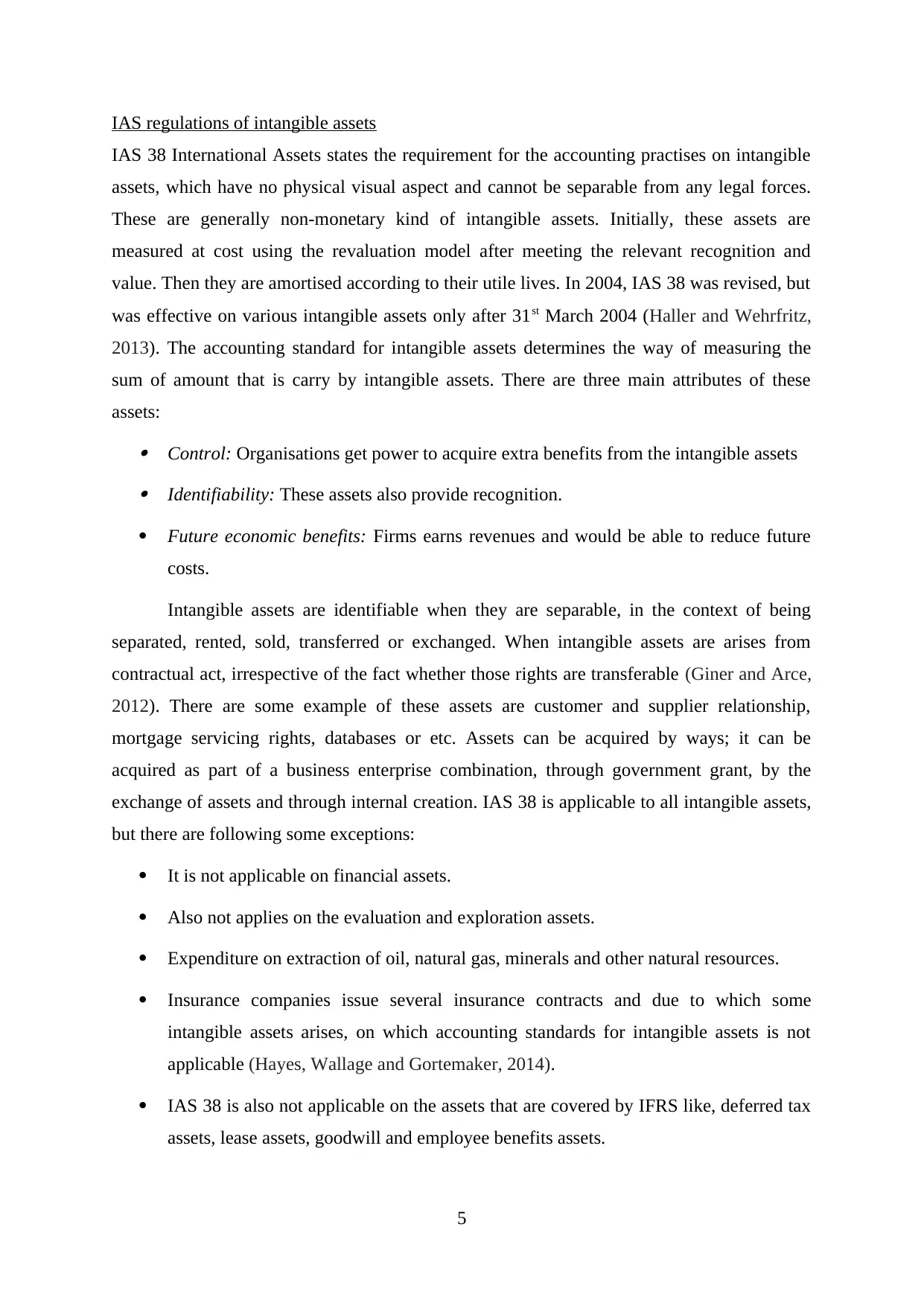
IAS regulations of intangible assets
IAS 38 International Assets states the requirement for the accounting practises on intangible
assets, which have no physical visual aspect and cannot be separable from any legal forces.
These are generally non-monetary kind of intangible assets. Initially, these assets are
measured at cost using the revaluation model after meeting the relevant recognition and
value. Then they are amortised according to their utile lives. In 2004, IAS 38 was revised, but
was effective on various intangible assets only after 31st March 2004 (Haller and Wehrfritz,
2013). The accounting standard for intangible assets determines the way of measuring the
sum of amount that is carry by intangible assets. There are three main attributes of these
assets: Control: Organisations get power to acquire extra benefits from the intangible assets Identifiability: These assets also provide recognition.
Future economic benefits: Firms earns revenues and would be able to reduce future
costs.
Intangible assets are identifiable when they are separable, in the context of being
separated, rented, sold, transferred or exchanged. When intangible assets are arises from
contractual act, irrespective of the fact whether those rights are transferable (Giner and Arce,
2012). There are some example of these assets are customer and supplier relationship,
mortgage servicing rights, databases or etc. Assets can be acquired by ways; it can be
acquired as part of a business enterprise combination, through government grant, by the
exchange of assets and through internal creation. IAS 38 is applicable to all intangible assets,
but there are following some exceptions:
It is not applicable on financial assets.
Also not applies on the evaluation and exploration assets.
Expenditure on extraction of oil, natural gas, minerals and other natural resources.
Insurance companies issue several insurance contracts and due to which some
intangible assets arises, on which accounting standards for intangible assets is not
applicable (Hayes, Wallage and Gortemaker, 2014).
IAS 38 is also not applicable on the assets that are covered by IFRS like, deferred tax
assets, lease assets, goodwill and employee benefits assets.
5
IAS 38 International Assets states the requirement for the accounting practises on intangible
assets, which have no physical visual aspect and cannot be separable from any legal forces.
These are generally non-monetary kind of intangible assets. Initially, these assets are
measured at cost using the revaluation model after meeting the relevant recognition and
value. Then they are amortised according to their utile lives. In 2004, IAS 38 was revised, but
was effective on various intangible assets only after 31st March 2004 (Haller and Wehrfritz,
2013). The accounting standard for intangible assets determines the way of measuring the
sum of amount that is carry by intangible assets. There are three main attributes of these
assets: Control: Organisations get power to acquire extra benefits from the intangible assets Identifiability: These assets also provide recognition.
Future economic benefits: Firms earns revenues and would be able to reduce future
costs.
Intangible assets are identifiable when they are separable, in the context of being
separated, rented, sold, transferred or exchanged. When intangible assets are arises from
contractual act, irrespective of the fact whether those rights are transferable (Giner and Arce,
2012). There are some example of these assets are customer and supplier relationship,
mortgage servicing rights, databases or etc. Assets can be acquired by ways; it can be
acquired as part of a business enterprise combination, through government grant, by the
exchange of assets and through internal creation. IAS 38 is applicable to all intangible assets,
but there are following some exceptions:
It is not applicable on financial assets.
Also not applies on the evaluation and exploration assets.
Expenditure on extraction of oil, natural gas, minerals and other natural resources.
Insurance companies issue several insurance contracts and due to which some
intangible assets arises, on which accounting standards for intangible assets is not
applicable (Hayes, Wallage and Gortemaker, 2014).
IAS 38 is also not applicable on the assets that are covered by IFRS like, deferred tax
assets, lease assets, goodwill and employee benefits assets.
5
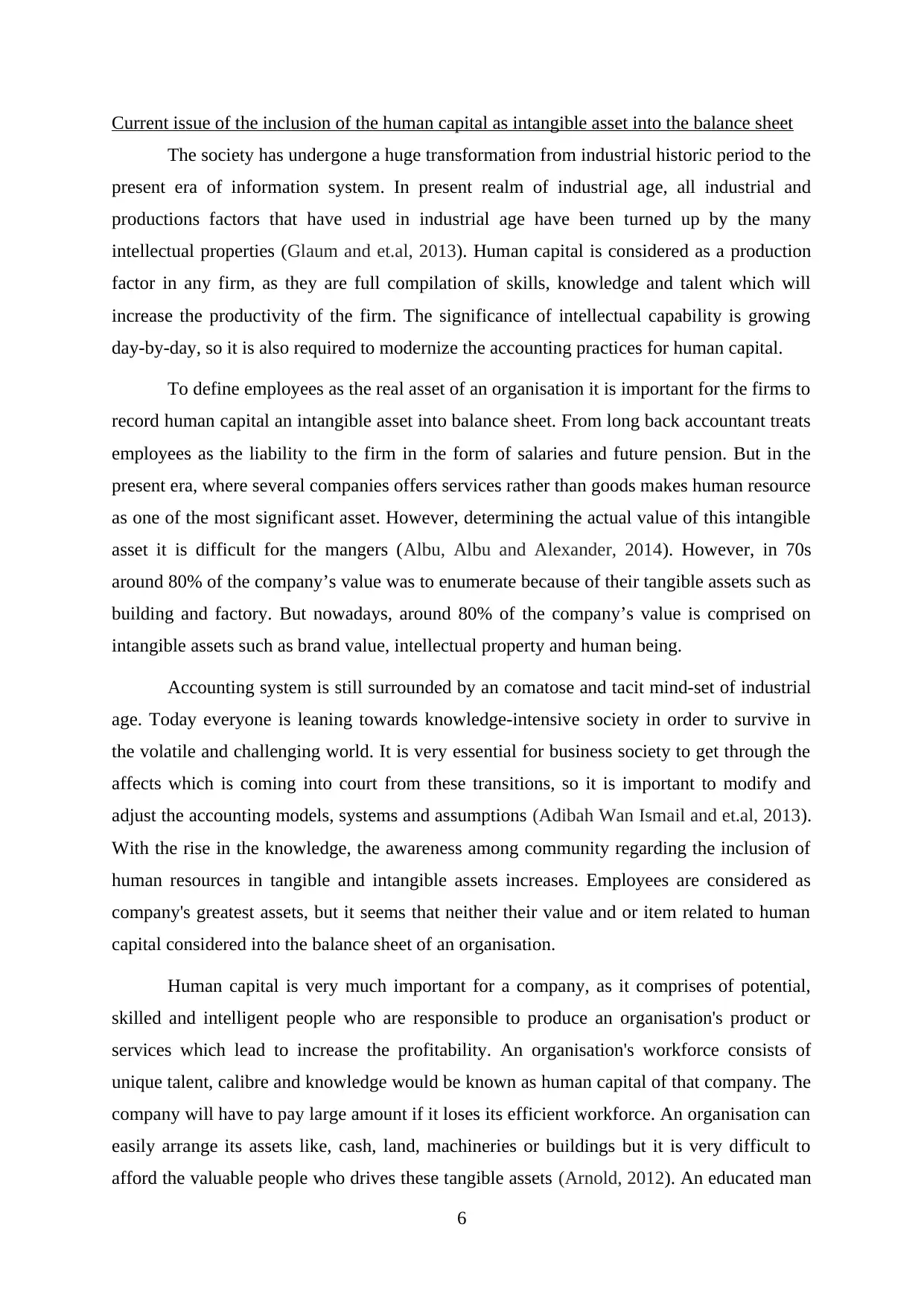
Current issue of the inclusion of the human capital as intangible asset into the balance sheet
The society has undergone a huge transformation from industrial historic period to the
present era of information system. In present realm of industrial age, all industrial and
productions factors that have used in industrial age have been turned up by the many
intellectual properties (Glaum and et.al, 2013). Human capital is considered as a production
factor in any firm, as they are full compilation of skills, knowledge and talent which will
increase the productivity of the firm. The significance of intellectual capability is growing
day-by-day, so it is also required to modernize the accounting practices for human capital.
To define employees as the real asset of an organisation it is important for the firms to
record human capital an intangible asset into balance sheet. From long back accountant treats
employees as the liability to the firm in the form of salaries and future pension. But in the
present era, where several companies offers services rather than goods makes human resource
as one of the most significant asset. However, determining the actual value of this intangible
asset it is difficult for the mangers (Albu, Albu and Alexander, 2014). However, in 70s
around 80% of the company’s value was to enumerate because of their tangible assets such as
building and factory. But nowadays, around 80% of the company’s value is comprised on
intangible assets such as brand value, intellectual property and human being.
Accounting system is still surrounded by an comatose and tacit mind-set of industrial
age. Today everyone is leaning towards knowledge-intensive society in order to survive in
the volatile and challenging world. It is very essential for business society to get through the
affects which is coming into court from these transitions, so it is important to modify and
adjust the accounting models, systems and assumptions (Adibah Wan Ismail and et.al, 2013).
With the rise in the knowledge, the awareness among community regarding the inclusion of
human resources in tangible and intangible assets increases. Employees are considered as
company's greatest assets, but it seems that neither their value and or item related to human
capital considered into the balance sheet of an organisation.
Human capital is very much important for a company, as it comprises of potential,
skilled and intelligent people who are responsible to produce an organisation's product or
services which lead to increase the profitability. An organisation's workforce consists of
unique talent, calibre and knowledge would be known as human capital of that company. The
company will have to pay large amount if it loses its efficient workforce. An organisation can
easily arrange its assets like, cash, land, machineries or buildings but it is very difficult to
afford the valuable people who drives these tangible assets (Arnold, 2012). An educated man
6
The society has undergone a huge transformation from industrial historic period to the
present era of information system. In present realm of industrial age, all industrial and
productions factors that have used in industrial age have been turned up by the many
intellectual properties (Glaum and et.al, 2013). Human capital is considered as a production
factor in any firm, as they are full compilation of skills, knowledge and talent which will
increase the productivity of the firm. The significance of intellectual capability is growing
day-by-day, so it is also required to modernize the accounting practices for human capital.
To define employees as the real asset of an organisation it is important for the firms to
record human capital an intangible asset into balance sheet. From long back accountant treats
employees as the liability to the firm in the form of salaries and future pension. But in the
present era, where several companies offers services rather than goods makes human resource
as one of the most significant asset. However, determining the actual value of this intangible
asset it is difficult for the mangers (Albu, Albu and Alexander, 2014). However, in 70s
around 80% of the company’s value was to enumerate because of their tangible assets such as
building and factory. But nowadays, around 80% of the company’s value is comprised on
intangible assets such as brand value, intellectual property and human being.
Accounting system is still surrounded by an comatose and tacit mind-set of industrial
age. Today everyone is leaning towards knowledge-intensive society in order to survive in
the volatile and challenging world. It is very essential for business society to get through the
affects which is coming into court from these transitions, so it is important to modify and
adjust the accounting models, systems and assumptions (Adibah Wan Ismail and et.al, 2013).
With the rise in the knowledge, the awareness among community regarding the inclusion of
human resources in tangible and intangible assets increases. Employees are considered as
company's greatest assets, but it seems that neither their value and or item related to human
capital considered into the balance sheet of an organisation.
Human capital is very much important for a company, as it comprises of potential,
skilled and intelligent people who are responsible to produce an organisation's product or
services which lead to increase the profitability. An organisation's workforce consists of
unique talent, calibre and knowledge would be known as human capital of that company. The
company will have to pay large amount if it loses its efficient workforce. An organisation can
easily arrange its assets like, cash, land, machineries or buildings but it is very difficult to
afford the valuable people who drives these tangible assets (Arnold, 2012). An educated man
6
⊘ This is a preview!⊘
Do you want full access?
Subscribe today to unlock all pages.

Trusted by 1+ million students worldwide

which possess skills, talent and dexterity should be comparable with expensive machineries
and other valuable property which are considered as assets.
Most of the companies experience failures to achieve their objective and goals due to
absence of brainpower in the workplace. Anybody can be robot, but it is very important to
use brain in order to bring changes. But still there is no acceptance from accounting standards
for measurement of capabilities of human resources (Tarca, Morris and Moy, 2013). Despite
the fact that there is great importance of human capital, the consent from accounting system
has not attained. The researches which are done on this topic is facing many challenges, so it
is required to find out an accurate way to place the human capital in the balance sheet.
Because their contribution for the success and growth of an organisation should be valued
and recognised. By including these assets in the balance sheet, a firm's reputation and
position in the competitive market tends to increase. Organisations should conduct surveys
and take reviews about the aforesaid issue. Google Docs can be used, which consists of
several questions on the same topic. Furthermore, companies can use various research tools
and techniques to get the view about the issue of inclusion of human assets in the balance
sheet (Christensen and et.al, 2015).
There is contradiction on the issue of inclusion of human assets into the balance sheet.
There are many valid results appeared like it is impossible to measure humans, also its
difficult task to maintain the consistency of same human. It is also stated that human capital
is not modifiable or manipulated, so the balance sheet of any company could be distorted.
Because human nature is very dynamic, it is impossible to stick with the same human.
However, there are several authors who argues that there is a challenge of formulating an
assigned value to human beings and even the risk that figures could be manipulated by varied
financial analyst (Giner and Arce, 2012). However, there are several valid reasons due to
which assigning of valuation to human capital has still not occurred because most
importantly, standards or principles like IFRS and GAAP does not require it. In addition to it,
people based companies are way behind in establishing a system of people based accounting.
While contradicting to this, there are certain authors who argues that companies does not own
people so they do not have any right to account them. However, this technically true but firms
take most out an employee to attain the best possible outcomes. In context to this, study of
balance sheet of company like Starbucks illustrates that, the property which they do not own
but operate upon considers as the lease an asset (Tarca, Morris and Moy, 2013).
7
and other valuable property which are considered as assets.
Most of the companies experience failures to achieve their objective and goals due to
absence of brainpower in the workplace. Anybody can be robot, but it is very important to
use brain in order to bring changes. But still there is no acceptance from accounting standards
for measurement of capabilities of human resources (Tarca, Morris and Moy, 2013). Despite
the fact that there is great importance of human capital, the consent from accounting system
has not attained. The researches which are done on this topic is facing many challenges, so it
is required to find out an accurate way to place the human capital in the balance sheet.
Because their contribution for the success and growth of an organisation should be valued
and recognised. By including these assets in the balance sheet, a firm's reputation and
position in the competitive market tends to increase. Organisations should conduct surveys
and take reviews about the aforesaid issue. Google Docs can be used, which consists of
several questions on the same topic. Furthermore, companies can use various research tools
and techniques to get the view about the issue of inclusion of human assets in the balance
sheet (Christensen and et.al, 2015).
There is contradiction on the issue of inclusion of human assets into the balance sheet.
There are many valid results appeared like it is impossible to measure humans, also its
difficult task to maintain the consistency of same human. It is also stated that human capital
is not modifiable or manipulated, so the balance sheet of any company could be distorted.
Because human nature is very dynamic, it is impossible to stick with the same human.
However, there are several authors who argues that there is a challenge of formulating an
assigned value to human beings and even the risk that figures could be manipulated by varied
financial analyst (Giner and Arce, 2012). However, there are several valid reasons due to
which assigning of valuation to human capital has still not occurred because most
importantly, standards or principles like IFRS and GAAP does not require it. In addition to it,
people based companies are way behind in establishing a system of people based accounting.
While contradicting to this, there are certain authors who argues that companies does not own
people so they do not have any right to account them. However, this technically true but firms
take most out an employee to attain the best possible outcomes. In context to this, study of
balance sheet of company like Starbucks illustrates that, the property which they do not own
but operate upon considers as the lease an asset (Tarca, Morris and Moy, 2013).
7
Paraphrase This Document
Need a fresh take? Get an instant paraphrase of this document with our AI Paraphraser
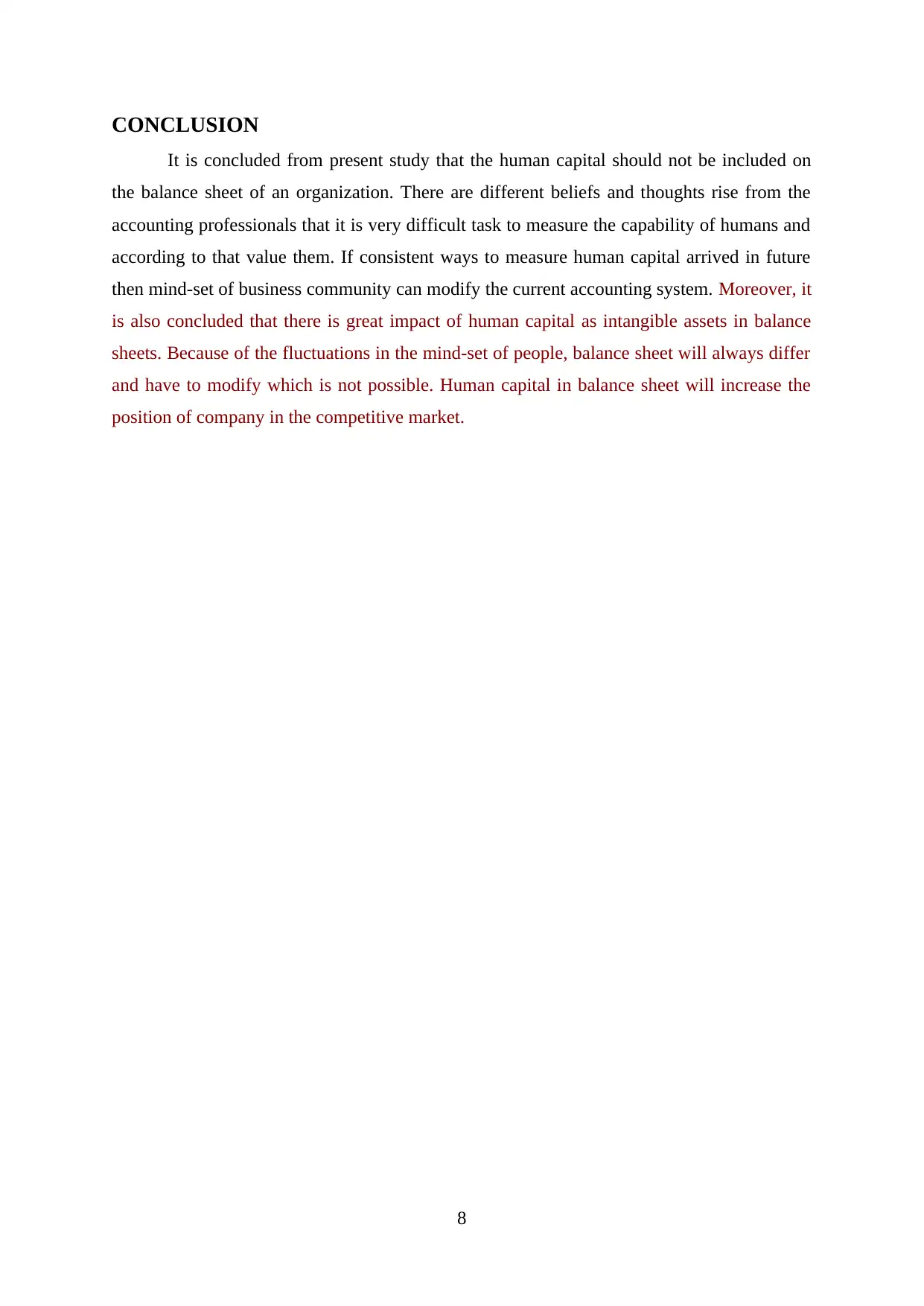
CONCLUSION
It is concluded from present study that the human capital should not be included on
the balance sheet of an organization. There are different beliefs and thoughts rise from the
accounting professionals that it is very difficult task to measure the capability of humans and
according to that value them. If consistent ways to measure human capital arrived in future
then mind-set of business community can modify the current accounting system. Moreover, it
is also concluded that there is great impact of human capital as intangible assets in balance
sheets. Because of the fluctuations in the mind-set of people, balance sheet will always differ
and have to modify which is not possible. Human capital in balance sheet will increase the
position of company in the competitive market.
8
It is concluded from present study that the human capital should not be included on
the balance sheet of an organization. There are different beliefs and thoughts rise from the
accounting professionals that it is very difficult task to measure the capability of humans and
according to that value them. If consistent ways to measure human capital arrived in future
then mind-set of business community can modify the current accounting system. Moreover, it
is also concluded that there is great impact of human capital as intangible assets in balance
sheets. Because of the fluctuations in the mind-set of people, balance sheet will always differ
and have to modify which is not possible. Human capital in balance sheet will increase the
position of company in the competitive market.
8
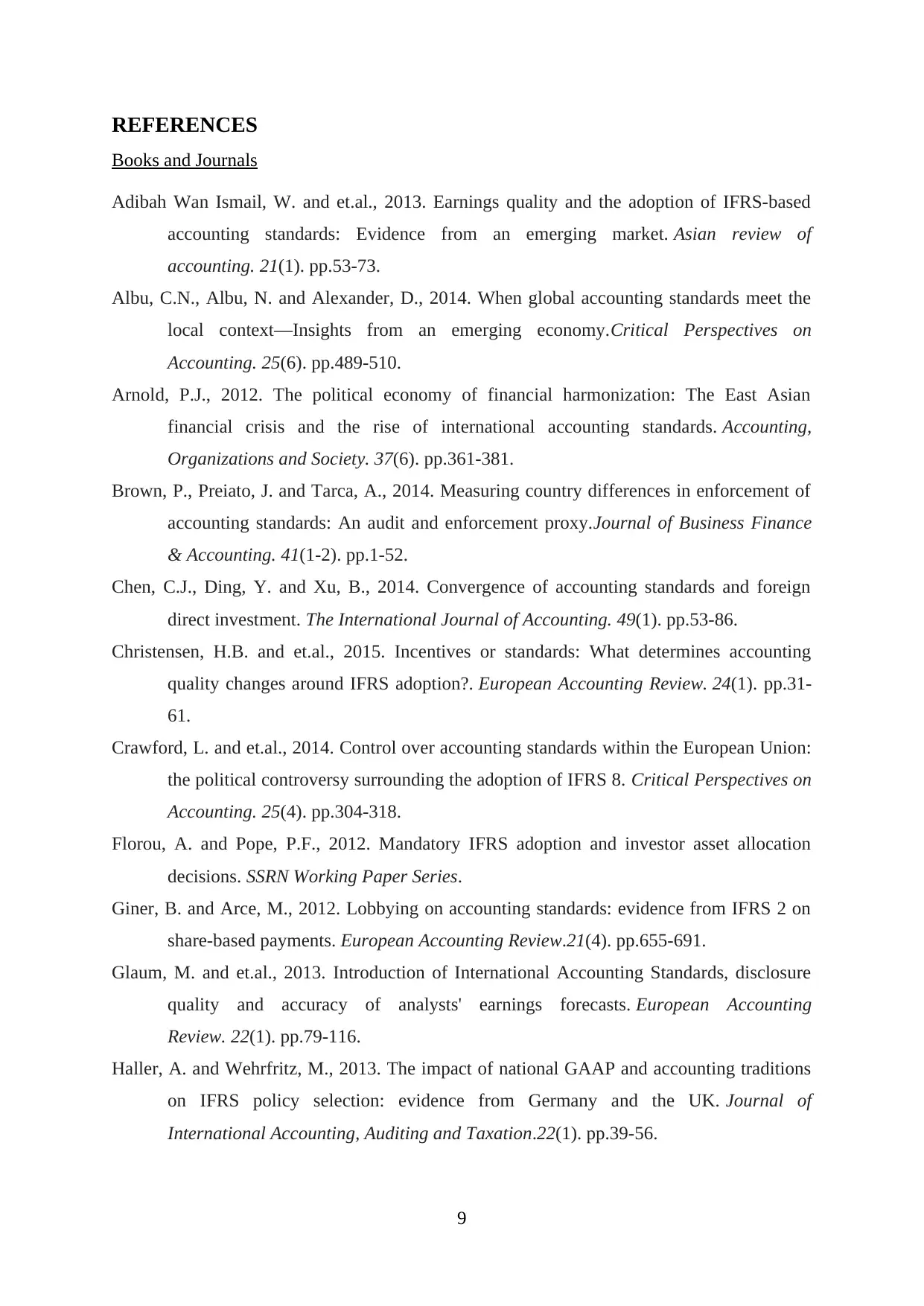
REFERENCES
Books and Journals
Adibah Wan Ismail, W. and et.al., 2013. Earnings quality and the adoption of IFRS-based
accounting standards: Evidence from an emerging market. Asian review of
accounting. 21(1). pp.53-73.
Albu, C.N., Albu, N. and Alexander, D., 2014. When global accounting standards meet the
local context—Insights from an emerging economy.Critical Perspectives on
Accounting. 25(6). pp.489-510.
Arnold, P.J., 2012. The political economy of financial harmonization: The East Asian
financial crisis and the rise of international accounting standards. Accounting,
Organizations and Society. 37(6). pp.361-381.
Brown, P., Preiato, J. and Tarca, A., 2014. Measuring country differences in enforcement of
accounting standards: An audit and enforcement proxy.Journal of Business Finance
& Accounting. 41(1-2). pp.1-52.
Chen, C.J., Ding, Y. and Xu, B., 2014. Convergence of accounting standards and foreign
direct investment. The International Journal of Accounting. 49(1). pp.53-86.
Christensen, H.B. and et.al., 2015. Incentives or standards: What determines accounting
quality changes around IFRS adoption?. European Accounting Review. 24(1). pp.31-
61.
Crawford, L. and et.al., 2014. Control over accounting standards within the European Union:
the political controversy surrounding the adoption of IFRS 8. Critical Perspectives on
Accounting. 25(4). pp.304-318.
Florou, A. and Pope, P.F., 2012. Mandatory IFRS adoption and investor asset allocation
decisions. SSRN Working Paper Series.
Giner, B. and Arce, M., 2012. Lobbying on accounting standards: evidence from IFRS 2 on
share-based payments. European Accounting Review.21(4). pp.655-691.
Glaum, M. and et.al., 2013. Introduction of International Accounting Standards, disclosure
quality and accuracy of analysts' earnings forecasts. European Accounting
Review. 22(1). pp.79-116.
Haller, A. and Wehrfritz, M., 2013. The impact of national GAAP and accounting traditions
on IFRS policy selection: evidence from Germany and the UK. Journal of
International Accounting, Auditing and Taxation.22(1). pp.39-56.
9
Books and Journals
Adibah Wan Ismail, W. and et.al., 2013. Earnings quality and the adoption of IFRS-based
accounting standards: Evidence from an emerging market. Asian review of
accounting. 21(1). pp.53-73.
Albu, C.N., Albu, N. and Alexander, D., 2014. When global accounting standards meet the
local context—Insights from an emerging economy.Critical Perspectives on
Accounting. 25(6). pp.489-510.
Arnold, P.J., 2012. The political economy of financial harmonization: The East Asian
financial crisis and the rise of international accounting standards. Accounting,
Organizations and Society. 37(6). pp.361-381.
Brown, P., Preiato, J. and Tarca, A., 2014. Measuring country differences in enforcement of
accounting standards: An audit and enforcement proxy.Journal of Business Finance
& Accounting. 41(1-2). pp.1-52.
Chen, C.J., Ding, Y. and Xu, B., 2014. Convergence of accounting standards and foreign
direct investment. The International Journal of Accounting. 49(1). pp.53-86.
Christensen, H.B. and et.al., 2015. Incentives or standards: What determines accounting
quality changes around IFRS adoption?. European Accounting Review. 24(1). pp.31-
61.
Crawford, L. and et.al., 2014. Control over accounting standards within the European Union:
the political controversy surrounding the adoption of IFRS 8. Critical Perspectives on
Accounting. 25(4). pp.304-318.
Florou, A. and Pope, P.F., 2012. Mandatory IFRS adoption and investor asset allocation
decisions. SSRN Working Paper Series.
Giner, B. and Arce, M., 2012. Lobbying on accounting standards: evidence from IFRS 2 on
share-based payments. European Accounting Review.21(4). pp.655-691.
Glaum, M. and et.al., 2013. Introduction of International Accounting Standards, disclosure
quality and accuracy of analysts' earnings forecasts. European Accounting
Review. 22(1). pp.79-116.
Haller, A. and Wehrfritz, M., 2013. The impact of national GAAP and accounting traditions
on IFRS policy selection: evidence from Germany and the UK. Journal of
International Accounting, Auditing and Taxation.22(1). pp.39-56.
9
⊘ This is a preview!⊘
Do you want full access?
Subscribe today to unlock all pages.

Trusted by 1+ million students worldwide
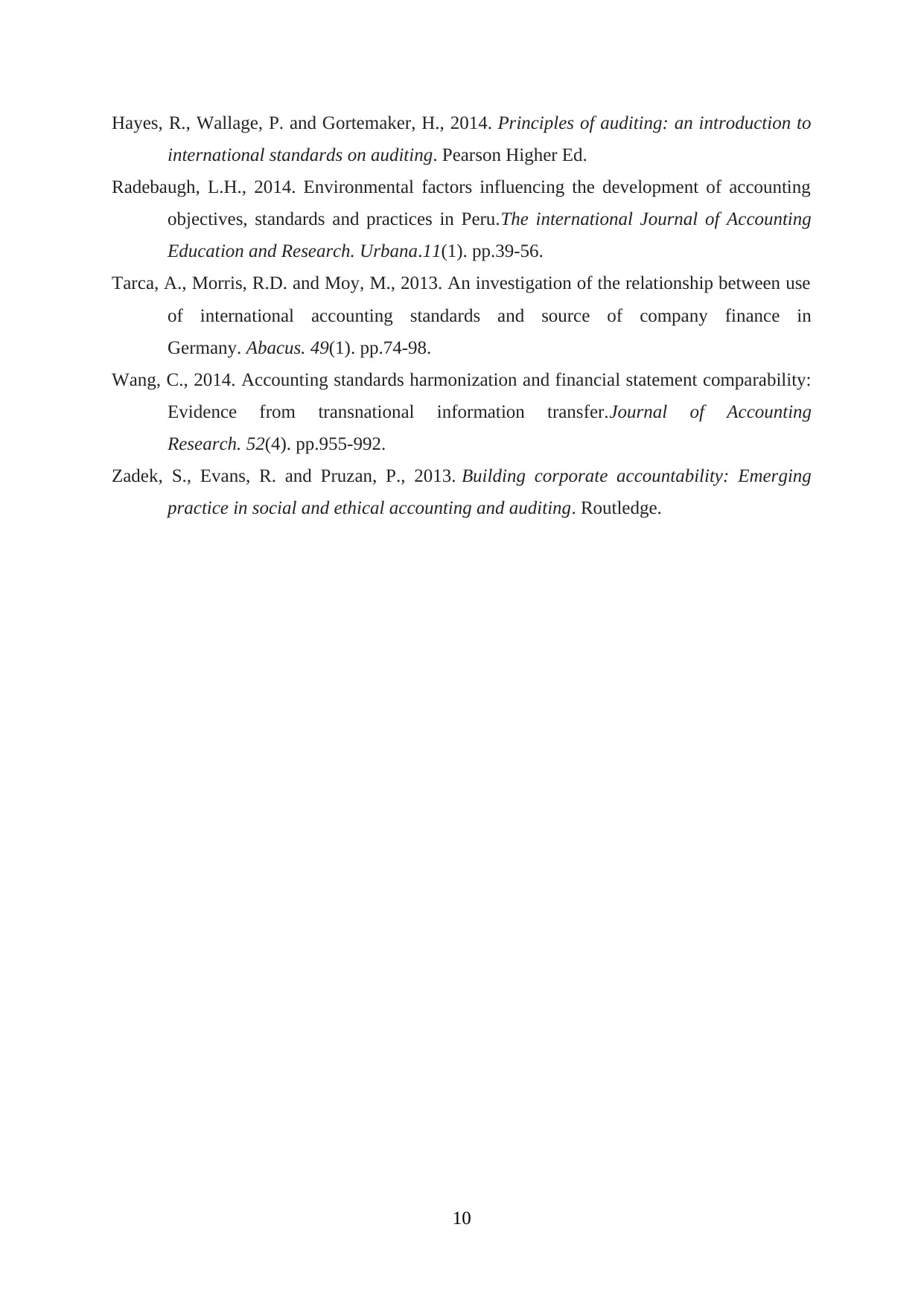
Hayes, R., Wallage, P. and Gortemaker, H., 2014. Principles of auditing: an introduction to
international standards on auditing. Pearson Higher Ed.
Radebaugh, L.H., 2014. Environmental factors influencing the development of accounting
objectives, standards and practices in Peru.The international Journal of Accounting
Education and Research. Urbana.11(1). pp.39-56.
Tarca, A., Morris, R.D. and Moy, M., 2013. An investigation of the relationship between use
of international accounting standards and source of company finance in
Germany. Abacus. 49(1). pp.74-98.
Wang, C., 2014. Accounting standards harmonization and financial statement comparability:
Evidence from transnational information transfer.Journal of Accounting
Research. 52(4). pp.955-992.
Zadek, S., Evans, R. and Pruzan, P., 2013. Building corporate accountability: Emerging
practice in social and ethical accounting and auditing. Routledge.
10
international standards on auditing. Pearson Higher Ed.
Radebaugh, L.H., 2014. Environmental factors influencing the development of accounting
objectives, standards and practices in Peru.The international Journal of Accounting
Education and Research. Urbana.11(1). pp.39-56.
Tarca, A., Morris, R.D. and Moy, M., 2013. An investigation of the relationship between use
of international accounting standards and source of company finance in
Germany. Abacus. 49(1). pp.74-98.
Wang, C., 2014. Accounting standards harmonization and financial statement comparability:
Evidence from transnational information transfer.Journal of Accounting
Research. 52(4). pp.955-992.
Zadek, S., Evans, R. and Pruzan, P., 2013. Building corporate accountability: Emerging
practice in social and ethical accounting and auditing. Routledge.
10
1 out of 10
Your All-in-One AI-Powered Toolkit for Academic Success.
+13062052269
info@desklib.com
Available 24*7 on WhatsApp / Email
![[object Object]](/_next/static/media/star-bottom.7253800d.svg)
Unlock your academic potential
© 2024 | Zucol Services PVT LTD | All rights reserved.

